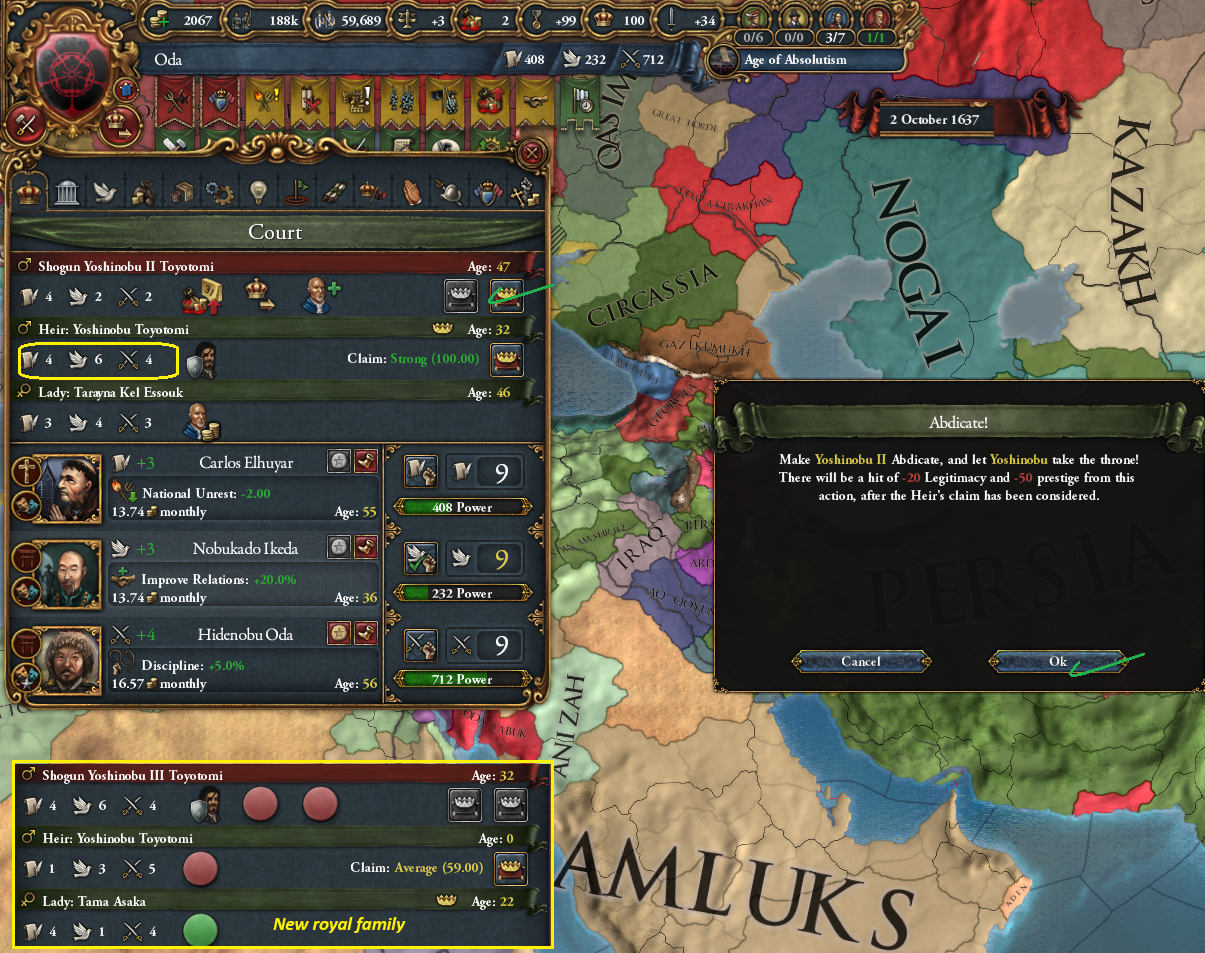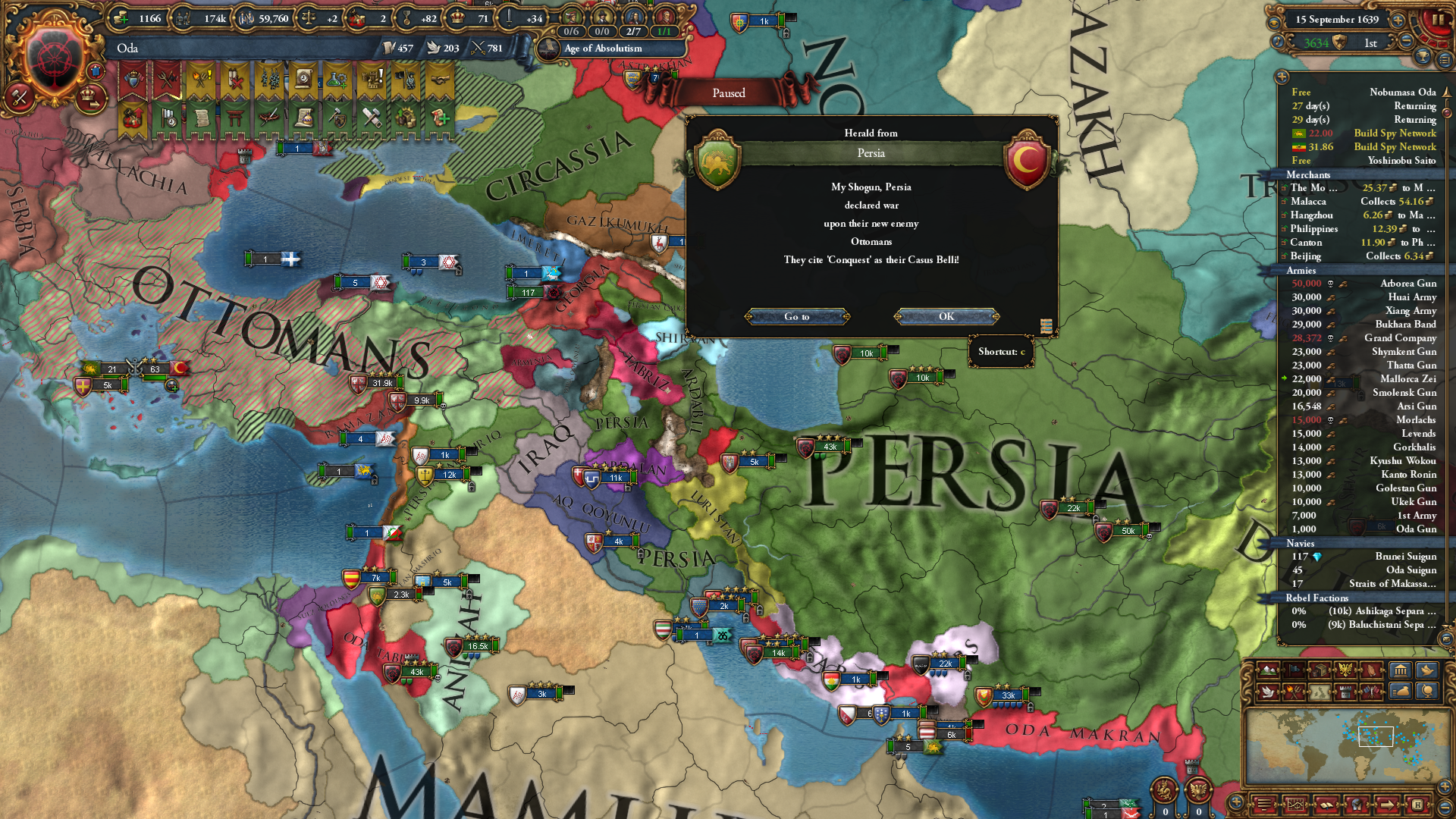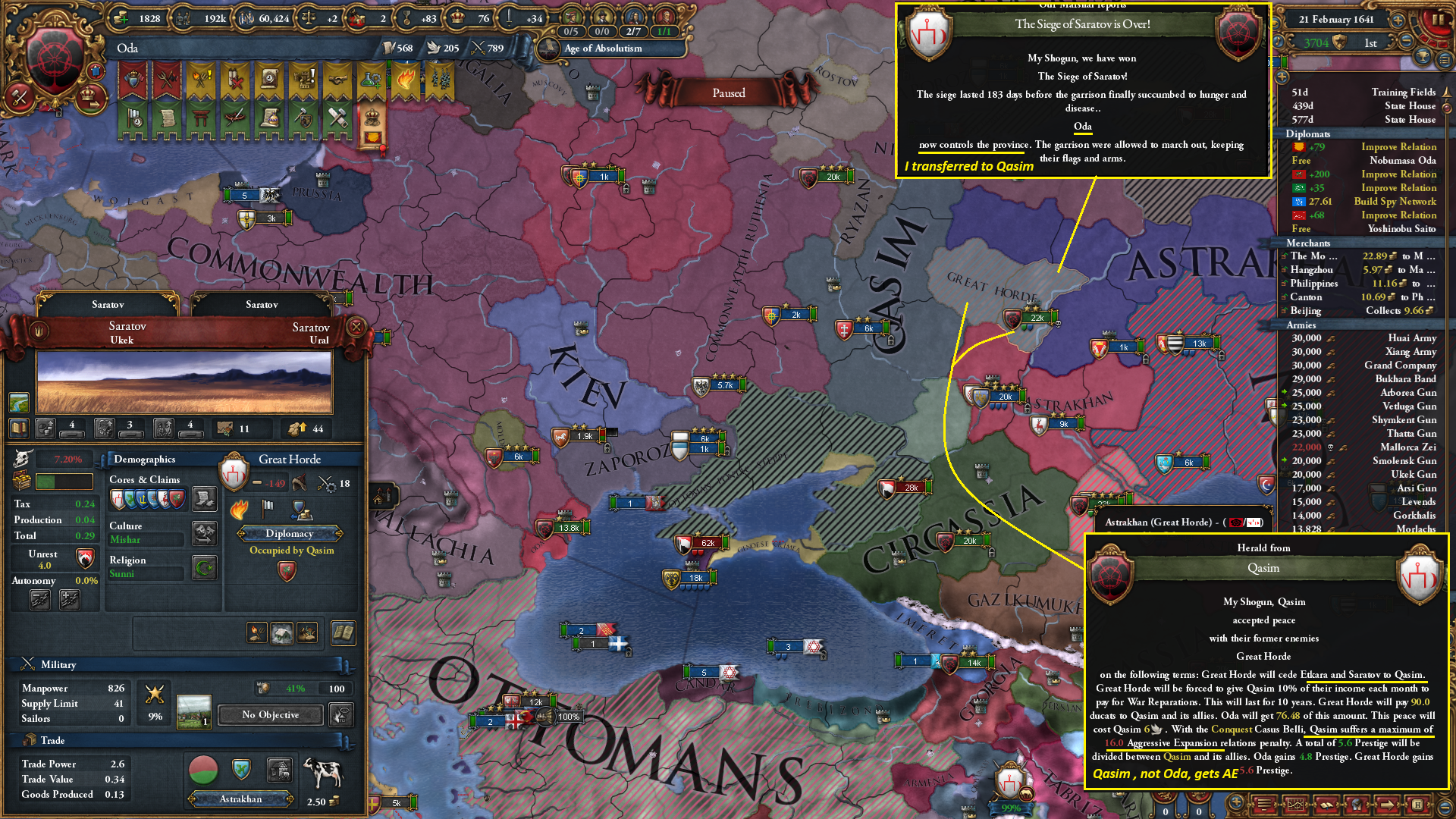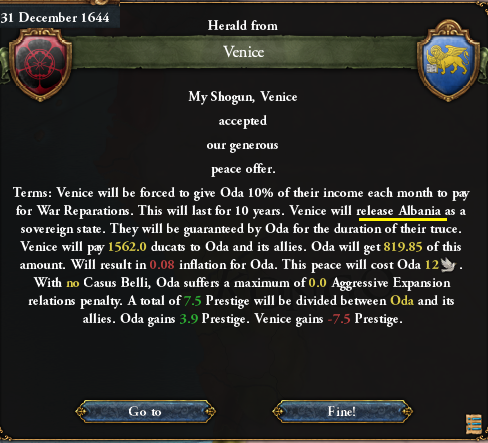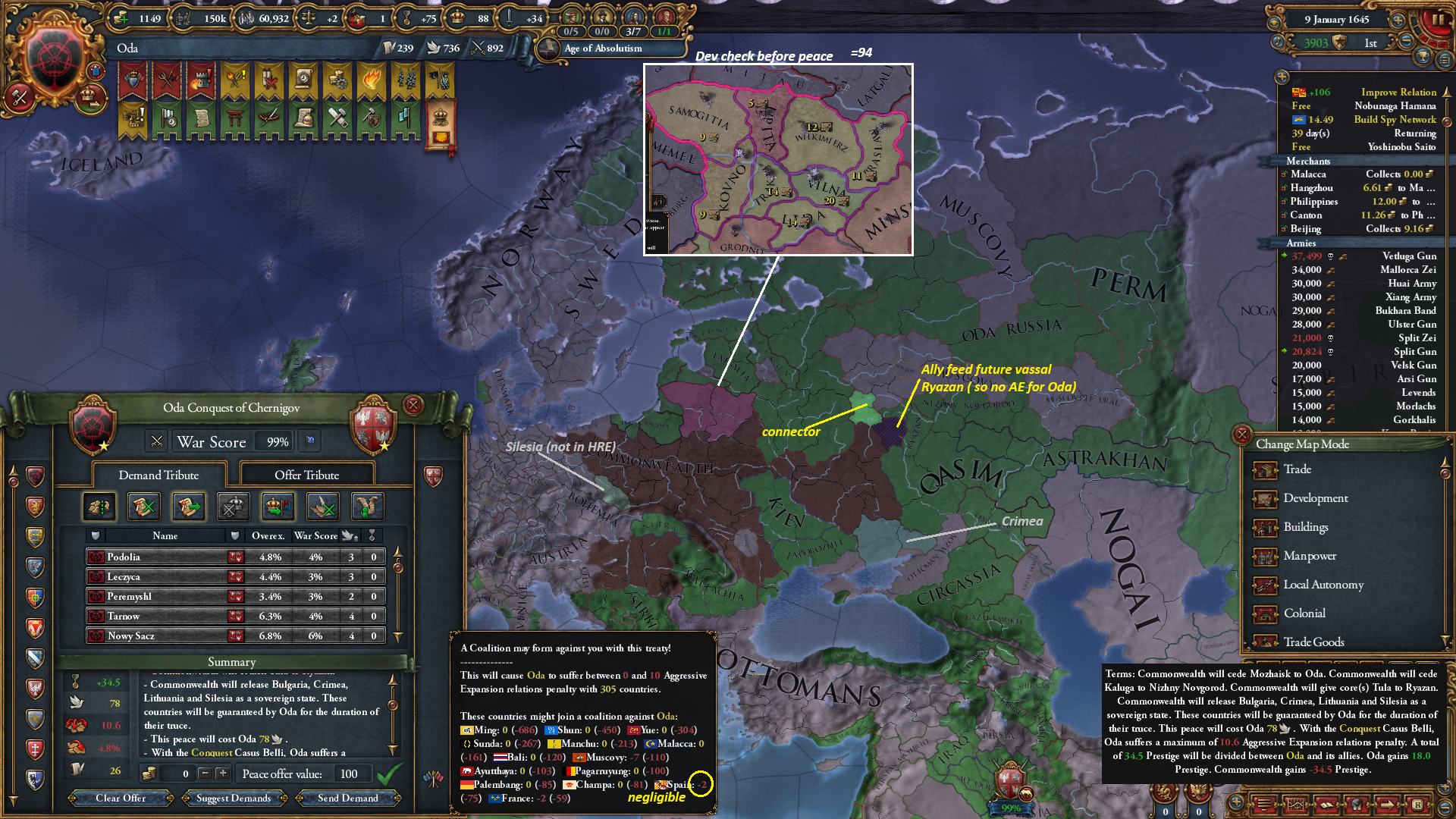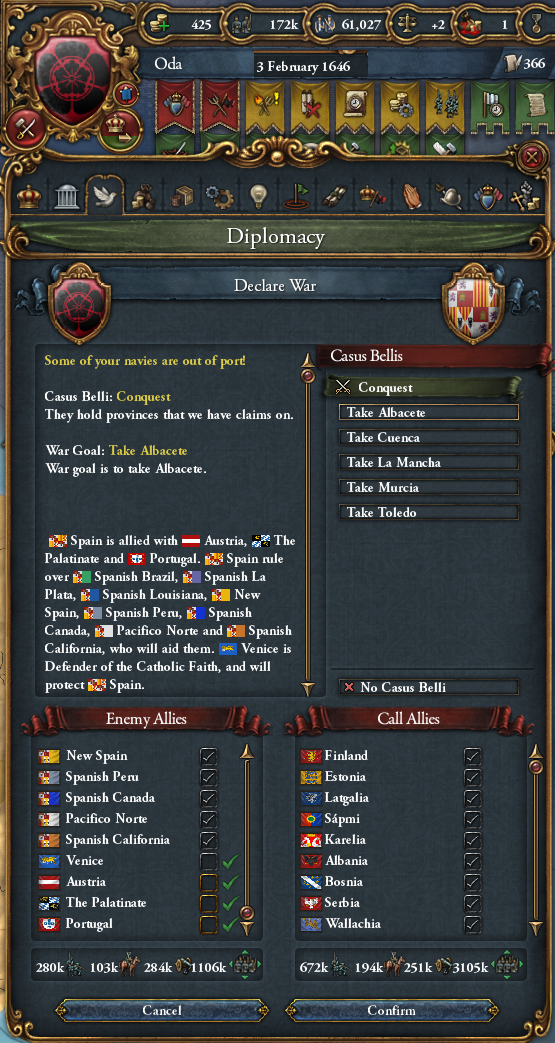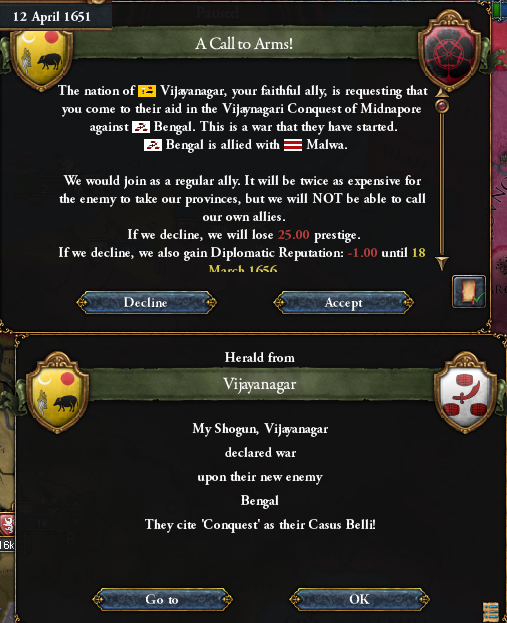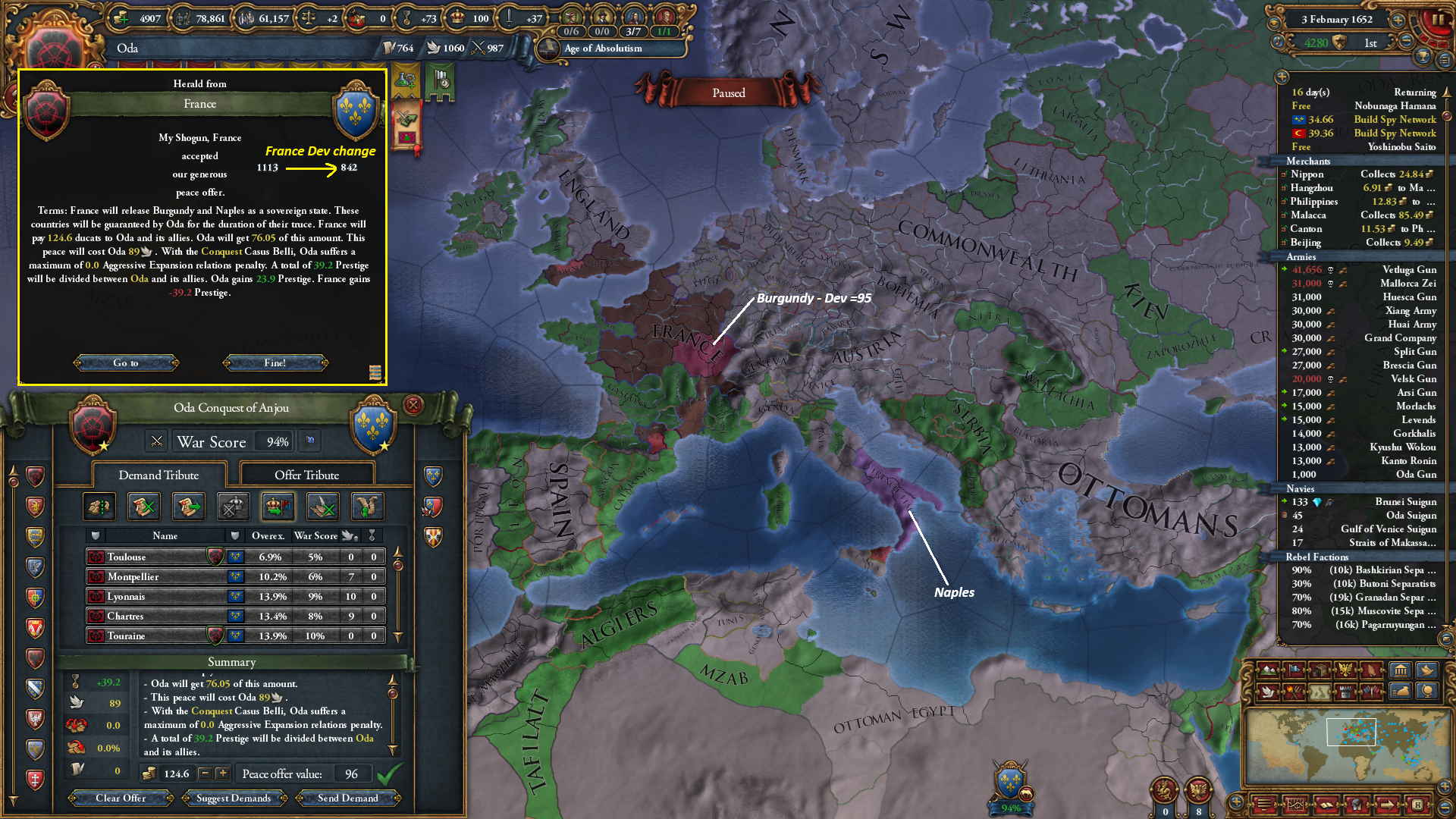Chapter 19: Art of The Deal ( 1630-1640)
We left the last chapter with Oda at war with Spain ( on round 3 of the Ottoman-Poland-Spain-France cycle). But the first notable event of the new decade was the beginning of the Nanban Trade incident of the Shinto faith. Like usual , the Shogun took the isolationist view.
After that it was time for peace with Spain, as more military gains were becoming harder to get.
Spain was forced to release Granada and Sardinia as independent nations . But , in contrast to more recent peace treaties, Oda also took provinces directly . That was because there were no more nations inside Spain to release. And Aragon would have been too large to become a Daimyo. The provinces Oda took were all cores of Aragon, and were distributed between Catalonia and Granada ( once the latter became a Daimyo) . That way, when the next war with Spain comes, Aragon could be released and could be turned into a Daimyo . This land grab of course created some aggressive expansion notoriety for Oda. This could become problematic for Oda as Spain was Catholic like most of Europe ( and Oda still had to dismantle the Catholic Empires of Poland, France and HRE). But for now this did not cause any issues.
This was soon followed by the vassalization of Algiers, which resulted in the two provinces that Portugal returned recently becoming part of the Odan domain. Considering that Oda gained those from a Catholic nation without incurring any Aggressive Expansion , that was a good deal for the Japanese.
After that it was France's turn.
France was allied to Scotland, who was designated as a co-belligerent since they still had cores of Irish nations that could be released to join the Daimyo family . But before we get to that, we detour to the Balkans where Serb rebels succeeded in breaking free from Poland.
Oda immediately guaranteed Serbia, to protect it from opportunistic jackals like Venice ( or Ottomans). And over time, with improved relations and gifts, Serbia became a Daimyo as well. Now Oda was very wary of Venetian growth because they were getting close to Empire status. Similarly, the SHogun had kept an eye on other growing nations, and had decided that the time had come to bring down Ayutthaya down a peg or two , as they were the largest nation not yet an Empire.
So war was declared on the Indochinese. That had the added benefit of shoring up Oda's trade situation in the far east as well.
Back in Europe the war with France and Scotland was proceeding smoothly. And it is a testimony to the power of the swarm that I do not feel the need to detail that war, and will just show one screenshot
And in international news that will be relevant down the line, a war between Mamluks and Persia was completed with a Persian victory
The unfortunate Syrians found themselves now completely under Persian occupation, with the Egyptians kicked further South. Clearly Persia was becoming one of the more problematic Empires for Oda to deal with, certainly more so than the Ottomans.
Back in Europe, peace was concluded with Scotland, with the release of future Daimyos Gaeldom, Ormond and Clanricarde.
That effectively gave Oda majority control of Ireland and a strong foothold in Britain itself. Brabant soon followed with a monetary peace ( no nations could be released, and no provinces were taken from the HRE member). Then France was to follow next, but first we detour back to Asia where Ayutthaya surrendered.
In the peace, Oda took all of Ayutthaya's provinces in Sumatra as well as their Center of Trade in Malacca node. That effectively secured Odan control of the node, and also made sure that Ayutthaya was not at risk of becoming an Empire any time soon.
Finally it was time for peace with France. Here Oda faced a similar challenge to the ones faced with Spain and with Syria before . France had no more small nations to release. Burgundy was too large . Naples could have been released, but the Shogun secretly hoped that one day rebels there would succeed. That left Brittany who was just too large to vassalize
But the Shogun did not repeat the Syria mistake. Having taken a survey of Brittany's size ahead of the peace treaty, he arranged for Cornwall to annex Finistere across the Channel. That put Brittany's development under 100 , allowing vassalization to proceed. And in February of he following year, Brittany joined the Daimyo family ( with the help of some Blackmailing espionage).
Now as we saw, Oda also had to take some land directly from France which added to the Aggressive Expansion accumulation with the Catholic nations of Europe. But Luckily for Oda, the next stops on the Empire bashing train were in the East against the Muslims nations of Ottomans and Persia. The Ottomans came up first in July 1635
And luckily for Oda, the Ottomans had allied the 6th Empire, that of Ethiopia . This saved Oda from having to work on getting a casus belli on the Ethiopians ( the plan was to get a neighboring province from Mamluks first, but that was not necessary anymore). Since maximal territorial degradation of Ethiopia was desirable, they were designated as co-belligerent, which did not affect the enemy line up at all.
The war followed the recent pattern of Odan troops leading the way against the enemy fortified cities, and letting the Daimyo swarm handle the rest. While that went on, Oda passed her 9th government reform. And the Shogun chose the Social Contract to improve the religious harmony inside the "Empire".
[I used same reform in True Tsar to keep a variety of religions in anticipation of flipping via rebels. same strat here]
By August 1637, Oda was ready for peace ( just two years were enough to conquer Ottomans, Ethiopia and their friends thanks to excellent siege ability and the swarm) . And when it make to the peace treaties, the Shogun wanted to maximize territorial gains while minimizing aggressive expansion reputation. So Odan diplomats had to be creative. In the case of Ottoman allies Kazakh and Transoxiana, they came up with the following
First Transoxiana was made to return several cores to Kazakh, while making sure the Kazakh size did not get over 100 development. Then Kazakh was made to pay money to Oda, but did not lose any land ( thanks to the cores returned from Transoxiana they actually paid more). Finally, once Oda was at peace, Kazakh was convinced to become a Daimyo , which was easy as they loved Oda for returning their provinces from Transoxiana. The end result of that deal was that Oda ended up taking a bunch of Transoxianan and Kazakh land with no aggressive expansion whatsoever.
The next deal was with Ethiopia.
The customary pattern was followed. One strategic province to Oda, with several minor nations released Unfortunately, only 2 of the 5 released nations became Daimyos ( Harer and Jimma), with the other three citing a far distance from Odan borders to accept
[in hindsight, I should have just flat out annexed Ethiopian clay, since they are the only Coptic nation and no one cares about them]
Finally, it was time for peace with the Ottomans.

In the peace Oda sought to maximize gains while still limiting aggressive expansion. But unfortunately the same problem we had with Spain and France ( the lack of small nations to release) appeared again. For some reason , Bulgaria could not be released ( likely because there was an active Bulgarian rebel army at the time ) . Crimea would have been too large to make into a Daimyo. So the Shogun had Ottomans release the one province minors of Greece ( in Chios) and Achaea ( in Euboea) as well as Ryazan and Kazan near Muscovy. All could be turned into Daimyos. He then had Oda annex a few province to her and to her vassals. But the largest number of provinces went to Qasim, who was an ally of Oda ( they were released out of Poland in a previous war ) . That way Qasim, not Oda, incurred the aggressive expansion reputation, but were very thankful to Oda and were still small enough to turn into a Daimyo ( their vassalization will be carried out after they are fed more land from Poland to their west) .
With the Ottomans dealt with in this round, it was time for Persia. But first there was a change in leadership in Oda, as Yoshinobu II ( 4/2/2) abdicated in favor of his younger half-brother Yoshinobu III ( 4/6/4) , the one who became heir after the hunting accident that killed Alon the Filipino. Clearly an ambitious lad who figured out a way to the throne. May he live long and prosper!
War was then declared on Persia on the day the truce expired ( May 1, 1638)
And although it was almost the end of the decade, the war was so swiftly concluded that we get to present the peace deal in this chapter
In the peace, Persia lost almost her entire coastline ( Hormuz is the only coastal province they still own). They were made to release Fars , Sindh and Armenia as free nations ( all three can become Daimyos).They also lost one Syrian province to Lebanon so that when Syria is released in the next war, she could be turned into a proper Daimyo as well. With that peace, the Shogun hoped to fragment the Persian Empire, and maybe rebels would help their westernmost provinces ( like Syria) break free. But he may have under-estimated the Persians, for they soon declared war on the Turks
As you can see from that last map, Ottomans were getting beaten in war by Poland as well. So there are certain to be changes to the map of the region in the next chapter. If Oda is lucky some of the changes would involve Ottomans losing land to someone who is neither Persia nor Poland, so that ODa would have less work to do .
We close with a view of ODa's dominion
and her aggressive expansion reputation













































